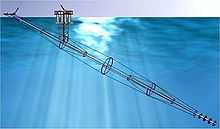Quicklaunch
| Type | Private |
|---|---|
| Industry | Aerospace |
| Founded | 2010 |
| Headquarters | California |
| Key people | John Hunter (scientist) |
| Website | quicklaunchinc.com |
Quicklaunch is a company attempting to use a type of space gun to launch payloads into low earth orbit.
Quicklauncher

The Quicklaunch proposed firing apparatus was a light gas gun using hydrogen as the working gas and natural gas as the explosive heat source. Heating and pre-pressurizing the hydrogen working gas takes 10 minutes before the shot and most of the hydrogen is recovered by a muzzle muffler at the end of the launch tube to be reused for subsequent launches.
The 1,100 metres (3,600 ft) long gun would be, for the most part, submerged in the ocean. Its horizontal and vertical direction (azimuth and elevation) could be adjusted based on customer launch requirements.
The proposed launcher was designed to give projectiles an initial speed of 6 km/s (3.7 mi/s). The projectile design included a one-stage rocket which ignites some time after launch. The designed payloads could include spacecraft, satellites, consumable, water or fuel to supply a propellant depot in orbit.
Projected dollar cost per pound to orbit were $500 ($1,100/kg)[1][2]
Project phases
- A one-year 2 million dollar project to break the record height of 180 kilometres (110 mi) for a projectile fired from a space gun, which was achieved in Project HARP.
- A two-year 10 million dollar project to launch to orbit a 1 kilogram (2.2 lb) payload each time.
- A two-year 50 million dollar project to launch to orbit a 45 kilograms (99 lb) payload each time.
- A three-year 500 million dollar project to launch to orbit a 450 kilograms (990 lb) payload each time, capable to supply 4 million lbs (2,000 tons) yearly and launching 5 times a day. (NOTE: 990lbs x 5 times a day x 365 days a year is only 1.8 million lbs)[3]
See also
References
- ↑ "Quicklaunch Inc - Affordable Space Exploration". Archived from the original on 2012-07-24. Retrieved February 14, 2012.
- ↑ "Cannons to the Planets". GoogleTechTalks. 2009.
- ↑ http://web.archive.org/web/20120927084853/http://quicklaunchinc.com/investors/space-exploration/
External links
- Shooting right for the stars with one gargantuan gas gun - Excerpt from 1996 Smithsonian Magazine on Hunter's work with SHARP. The final paragraph contains the financial assessment.
- SHARP Gun Accelerates Scramjets to Mach 9", by William B Scott, Aviation Week and Space Technology, September 9, 1996, page 63.
- Encyclopedia Astronautica - SHARP
- Video Interview of John Hunter - Gas Station In Space moonandback 2011
- Audio Interview of John Hunter on The space show
- "The Feasibility of Launching Small Satellites with a Light Gas Gun". CiteSeerX: 10.1.1.203.4552: detailed PDF of a land based version
| ||||||||||||||||||||||||||||||||||||||||||||||||
